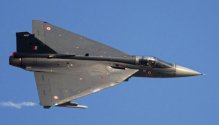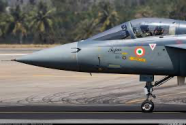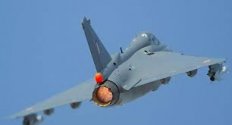I'm calling bullshit on that. Vertical stabilizer alone makes the RCS on par with F-16.Tejas has smallest RCS among all 4th Gen fighter jets in the world the Mark 1 variant has RCS of 0.5 meter square which will reduce further in Mark1A
It's the lightest fighter jet in the world thanks to carbon composite airframe
It's 95% carbon composite by surface area and 45% carbon composite by weight
You are using an out of date browser. It may not display this or other websites correctly.
You should upgrade or use an alternative browser.
You should upgrade or use an alternative browser.
Indian Military News, Reports, Data, etc.
- Thread starter bd popeye
- Start date
Tejas has thrust to weight ratio of 1.07
You have assumed that there are no RCS reduction measures in the design of Tejas I will answer you point by point with pictures later
I need some time to collect the pictures showing why and how Tejas has smallest RCS among 4th Gen fighters
Btw the figure of 0.5 meter square of RCS is from Hindustan Aeronautics Limited not me
0.94 according to Wiki. Reference [234] is to
The F404-GE-IN20 is quoted at 20,200 lbf.
The F414 is at 22,000 lbf but we'll have to wait until 2024 to find out the final specs for the Mk.1A.
Below is pasted from Wiki:
Performance
- Maximum speed: 1,980 km/h (1,230 mph, 1,070 kn)
- Maximum speed: Mach 1.6
- Range: 1,850 km (1,150 mi, 1,000 nmi)
- Combat range: 500 km (310 mi, 270 nmi) with internal fuel
- Ferry range: 3,200 km (1,986 mi, 1,726 nmi) with 2 external drop tanks
- Service ceiling: 16,000 m (53,500 ft)
- g limits: +9/−3.5
- Wing loading: 255.2 kg/m2 (52.3 lb/sq ft)
- : 0.94
I imagine that reply is saying India's material/design weight control issues manifest itself in both fighter jets and orbital rocket systems.Are you sure that you are replying to the correct thread?
Understood. Initially, I thought he was meant to reply to the China Space Thread. Thanks for the clarification.I imagine that reply is saying India's material/design weight control issues manifest itself in both fighter jets and orbital rocket systems.
Wikipedia is not always correct , The ferry range and combat range of Tejas FOC has increased and will increase further in MK1A because weight of Tejas MK1A is 1000kg less than Tejas MK1 , MK1 weighs 6500 kg and MK1A weighs 5500 kg0.94 according to Wiki. Reference [234] is to
The F404-GE-IN20 is quoted at 20,200 lbf.
The F414 is at 22,000 lbf but we'll have to wait until 2024 to find out the final specs for the Mk.1A.
Below is pasted from Wiki:
Performance
The thrust to weight ratio of HAL Tejas Mk1, considering its gross weight and thrust produced by the engines with afterburner is equal to 20,200 lbf / 26,500 lb, i.e., 0.94. The result may vary if you consider different types of weight or thrust.
- Maximum speed: 1,980 km/h (1,230 mph, 1,070 kn)
- Maximum speed: Mach 1.6
- Range: 1,850 km (1,150 mi, 1,000 nmi)
- Combat range: 500 km (310 mi, 270 nmi) with internal fuel
- Ferry range: 3,200 km (1,986 mi, 1,726 nmi) with 2 external drop tanks
- Service ceiling: 16,000 m (53,500 ft)
- g limits: +9/−3.5
- Wing loading: 255.2 kg/m2 (52.3 lb/sq ft)
- : 0.94
Last edited:
Thrust to weight ratio of Tejas ranges between 1 to 1.07 depending on the amount of fuel0.94 according to Wiki. Reference [234] is to
The F404-GE-IN20 is quoted at 20,200 lbf.
The F414 is at 22,000 lbf but we'll have to wait until 2024 to find out the final specs for the Mk.1A.
Below is pasted from Wiki:
Performance
The thrust to weight ratio of HAL Tejas Mk1, considering its gross weight and thrust produced by the engines with afterburner is equal to 20,200 lbf / 26,500 lb, i.e., 0.94. The result may vary if you consider different types of weight or thrust.
- Maximum speed: 1,980 km/h (1,230 mph, 1,070 kn)
- Maximum speed: Mach 1.6
- Range: 1,850 km (1,150 mi, 1,000 nmi)
- Combat range: 500 km (310 mi, 270 nmi) with internal fuel
- Ferry range: 3,200 km (1,986 mi, 1,726 nmi) with 2 external drop tanks
- Service ceiling: 16,000 m (53,500 ft)
- g limits: +9/−3.5
- Wing loading: 255.2 kg/m2 (52.3 lb/sq ft)
- : 0.94
and it’s for MK1 , will increase further in MK1A because of weight of MK1A is 1000kg less than MK1 FOC
@FairAndUnbiased @Jason_
The RCS of Tejas has been brought down significantly by modifying shape aspects within the limitations set by aerodynamics. Tejas got one of the best RCS value in the entire 4th generation fighters. Publically available figure is 0.5 meter square.
Tejas is a light aircraft. It is the smallest. It is difficult to have a view of it even in a WVR dogfight making it even more lethal and deadly.
The smooth upper wing body blending of Tejas gives it enough Stealth to avoid early detection. This kind of upper body blending is only being seen in later generation fighters from sukhoi, rafale, euro fighter typhoon, F-22, PAKFA, and J-20. This high wing body blending is the hall mark of even the fifth gen fighters, reducing the corner reflections from the awacs radars searching from above resulting in lower RCS with missiles and external sores hidden under the wing.
Tejas design incorporates a high wing body fuselage blending implemented from behind, resulting in smooth bouncing off of searching radar waves from behind whether they are X band or L band or AESA or mechanical it does not matter. If Tejas flies low hiding its stores no airborne radar will detect it from beyond 120 kms due to 0.3 sq meter rcs.
High wing body fuselage blending is implemented from behind,resulting in smooth bouncing off Radar Waves
Another stealth feature of Tejas is its Y intake also called bifurcated intake. Engine fan blades are one of the prominent sources of increasing radar cross section. This Y intake buried the jet engine inside the fuselage so no engine parts are visible and thus increases the stealth characteristics.
Canopy is another good radar reflector. Radar waves normally enter the cockpit reflects of objects & possibly return to the radar and even the HMD of pilot itself contributes to RCS. To avoid this Tejas canopy is coated with a thin film transparent conductor of Indium Tin Oxide. The coating is thin enough that it has no adverse effect on pilot vision and can reflect the radar waves away from the radar antenna.
Almost 90% of the surface of Tejas is made by carbon composites. These composites are much less reflective than metals. This helps in reduction of the RCS of Tejas. The Tejas employs CFC materials for up to 45% of its airframe, including in the fuselage (doors and skins), wings (skin, spars and ribs), elevons, tailfin, rudder, air brakes and landing gear doors.
Composites are used to make an aircraft both lighter and stronger at the same time compared to an all-metal design, and the LCA's percentage employment of CFCs is one of the highest among contemporary aircraft of its class. Some reports saying India also developing carbon nano tube reinforced carbon composites for future use this will lead to further reduction in RCS.
CFC have other advantages they don’t deteriorate with age nor corrode due weather elements, CFC also gives Tejas better operational empty weight giving Tejas better thrust to weight ratio when compared with other aircrafts with similar engines. CFC does have their own disadvantages, there are expensive to make.
India already got patent in RAM coatings. The use of RAM coatings further decreases its RCS dramatically. Better coatings are under researching.
Tejas is a single engine aircraft so it is inherently less susceptible to IRSTs compared to twin engine aircrafts. ADA pointed out that they already reduced the IR signature of Tejas. Making it more survivable against heat seeking missiles.[/QUOTE]
The RCS of Tejas has been brought down significantly by modifying shape aspects within the limitations set by aerodynamics. Tejas got one of the best RCS value in the entire 4th generation fighters. Publically available figure is 0.5 meter square.
Tejas is a light aircraft. It is the smallest. It is difficult to have a view of it even in a WVR dogfight making it even more lethal and deadly.
The smooth upper wing body blending of Tejas gives it enough Stealth to avoid early detection. This kind of upper body blending is only being seen in later generation fighters from sukhoi, rafale, euro fighter typhoon, F-22, PAKFA, and J-20. This high wing body blending is the hall mark of even the fifth gen fighters, reducing the corner reflections from the awacs radars searching from above resulting in lower RCS with missiles and external sores hidden under the wing.
Tejas design incorporates a high wing body fuselage blending implemented from behind, resulting in smooth bouncing off of searching radar waves from behind whether they are X band or L band or AESA or mechanical it does not matter. If Tejas flies low hiding its stores no airborne radar will detect it from beyond 120 kms due to 0.3 sq meter rcs.
High wing body fuselage blending is implemented from behind,resulting in smooth bouncing off Radar Waves
Another stealth feature of Tejas is its Y intake also called bifurcated intake. Engine fan blades are one of the prominent sources of increasing radar cross section. This Y intake buried the jet engine inside the fuselage so no engine parts are visible and thus increases the stealth characteristics.
Canopy is another good radar reflector. Radar waves normally enter the cockpit reflects of objects & possibly return to the radar and even the HMD of pilot itself contributes to RCS. To avoid this Tejas canopy is coated with a thin film transparent conductor of Indium Tin Oxide. The coating is thin enough that it has no adverse effect on pilot vision and can reflect the radar waves away from the radar antenna.
Almost 90% of the surface of Tejas is made by carbon composites. These composites are much less reflective than metals. This helps in reduction of the RCS of Tejas. The Tejas employs CFC materials for up to 45% of its airframe, including in the fuselage (doors and skins), wings (skin, spars and ribs), elevons, tailfin, rudder, air brakes and landing gear doors.
Composites are used to make an aircraft both lighter and stronger at the same time compared to an all-metal design, and the LCA's percentage employment of CFCs is one of the highest among contemporary aircraft of its class. Some reports saying India also developing carbon nano tube reinforced carbon composites for future use this will lead to further reduction in RCS.
CFC have other advantages they don’t deteriorate with age nor corrode due weather elements, CFC also gives Tejas better operational empty weight giving Tejas better thrust to weight ratio when compared with other aircrafts with similar engines. CFC does have their own disadvantages, there are expensive to make.
India already got patent in RAM coatings. The use of RAM coatings further decreases its RCS dramatically. Better coatings are under researching.
Tejas is a single engine aircraft so it is inherently less susceptible to IRSTs compared to twin engine aircrafts. ADA pointed out that they already reduced the IR signature of Tejas. Making it more survivable against heat seeking missiles.[/QUOTE]
Attachments
@Jason_
Tejas being the best 4th generation fighter jet is not my hunch I have come to this conclusion only after analysing the specs of this fighter jet
Tejas took first flight in 2001 and was inducted into service in 2016 so it's the latest 4th generation fighter jet in the world it's obvious that it would be more capable than those fighter jets which were designed 40 or 50 years ago F16 for example
Lockheed Martin might have upgraded the F16 they modified it but that doesn't change the basic design of this aircraft it's an outdated design , Tejas is a modern design and that's the reason why they designed it to have small RCS
Having small RCS was not even under consideration when F16 was being designed that era was completely different
Tejas being the best 4th generation fighter jet is not my hunch I have come to this conclusion only after analysing the specs of this fighter jet
Tejas took first flight in 2001 and was inducted into service in 2016 so it's the latest 4th generation fighter jet in the world it's obvious that it would be more capable than those fighter jets which were designed 40 or 50 years ago F16 for example
Lockheed Martin might have upgraded the F16 they modified it but that doesn't change the basic design of this aircraft it's an outdated design , Tejas is a modern design and that's the reason why they designed it to have small RCS
Having small RCS was not even under consideration when F16 was being designed that era was completely different
Vertical stabilizer isn't that important for direct frontal RCS.I'm calling bullshit on that. Vertical stabilizer alone makes the RCS on par with F-16.
Overall claim that Tejas may be quite sneaky for a non-stealth a/c may very well be close to truth - it's really very small, and it was designed after RCS design long stopped being a special knowledge for premier a/c design houses.



